
Both the tobacco and tomato hornworms are the larval stage of the same family of moths, which is like saying they’re long-distance relatives. They may share some similarities, but a few key differences set them apart. Knowing their distinctive traits can help you determine how to deal with them effectively, ensuring your garden flourishes without too much worry.
What Are Tobacco and Tomato Hornworms?
First off, it’s essential to know what you’re dealing with. Both tobacco and tomato hornworms are the larvae of moths from the family Sphingidae. You might encounter them in your garden, especially if you grow nightshade plants like tomatoes, peppers, or eggplants.
– Tobacco Hornworm: This critter primarily targets tobacco plants but will also munch on tomatoes, peppers, and eggplants. They’re known for their voracious appetite and can do some serious damage in a short amount of time.
– Tomato Hornworm: As the name implies, these guys are better known as tomato lovers. They’ll focus on tomatoes but can also snack on other nightshades. They’re infamous for the rapid destruction they can cause in a garden setting.
Identifying these caterpillars correctly is the first step toward effective pest management.
Physical Differences
When it comes to physical appearance, there are some noticeable distinctions that can help you tell these two hornworms apart.
– Color and Markings: Tobacco hornworms are typically green but may have a more bluish or yellowish hue. They also feature seven diagonal white stripes running down their sides. In contrast, tomato hornworms are a solid green with a distinctive “V” shaped pattern on the side and, sometimes, faint white stripes as well.
– Size: Both caterpillars can grow quite large, usually reaching about 3-4 inches long when fully grown. However, some gardeners swear that tobacco hornworms appear slightly larger and bulkier due to their feeding habits.
Paying close attention to these features can save you time when identifying which pest is invading your garden.
Behavior and Feeding Habits
Now, let’s talk about what these hornworms do once they settle in your garden.
– Feeding Patterns: Tobacco hornworms are notorious for their aggressive feeding. They can strip a plant of its leaves almost overnight, creating a scene that looks like a miniature tornado hit your tomatoes. The tomato hornworm, while also destructive, tends to be slightly less voracious. They’ll devour leaves, blossoms, and even fruits, but may do so more gradually.
– Time of Day: If you observe your plants in the morning, you might catch these caterpillars in action. Both types are mainly nocturnal feeders; however, tobacco hornworms are known to be a bit more active during the day. This means you might spot them more frequently if you’re checking on your plants in broad daylight.
Understanding their feeding behavior can help you take action before they cause extensive damage.
Life Cycle and Reproduction
Both tobacco and tomato hornworms go through similar life stages, but there are some nuances worth mentioning.
– Egg Laying: Female moths typically lay eggs on the underside of leaves, which caterpillars hatch from after a few days. Tobacco hornworms prefer laying on tobacco plants, while tomato hornworms favor, you guessed it, tomatoes.
– Pupa Stage: Once they’ve fed enough, they’ll drop to the ground and burrow into the soil to pupate. The pupal stage can last about two weeks, after which they emerge as moths ready to start the cycle again. Interestingly, the tobacco hornworm’s pupae tend to have a slightly longer lifespan than those of their tomato-loving relatives, especially in cooler climates.
This cycle is crucial to understand for ongoing pest management, as a new batch of caterpillars can appear in your garden much faster than you think.
Damage Assessment
Understanding the kind of damage these pests can do is vital for any gardener.
– Tobacco Hornworm Damage: They tend to be more aggressive, often stripping a plant bare. If you notice large holes in leaves or entire plants turning yellow and wilting, you might be dealing with these hornworms.
– Tomato Hornworm Damage: While they can also cause significant damage, their feeding may be slightly less destructive in terms of speed. They usually target the leaves and fruits first, so be on the lookout for frayed edges on leaves and missing sections of fruit.
Being proactive and recognizing the signs early can save your plants from suffering severe damage.
Control Methods
Dealing with hornworms isn’t just about identification. You also need a solid plan for managing them.
– Organic Solutions: If you’re looking for an eco-friendly approach, consider introducing natural predators like parasitic wasps that target hornworm larvae. You can also use insecticidal soap or neem oil, which can help reduce their population without harming beneficial insects.
– Manual Removal: Sometimes, a hands-on approach works best. You can simply handpick these pests off your plants and dispose of them. Just make sure to wear gloves if you’re squeamish!
Choosing the right control method depends on your gardening philosophy and the resources you have at hand.
Getting to know the differences between tobacco hornworms and tomato hornworms is like having a cheat sheet for your garden. Each has its unique traits, feeding habits, and damage potential, but understanding them can make all the difference in protecting your beloved plants.
By recognizing their appearances, habits, and potential impacts, you’re better equipped to manage these pests effectively. Whether you choose organic methods, manual removal, or a mix of both, keeping an eye out for these little munchers will allow you to enjoy your gardening experience to the fullest. Remember, happy gardening is all about being informed and prepared!

